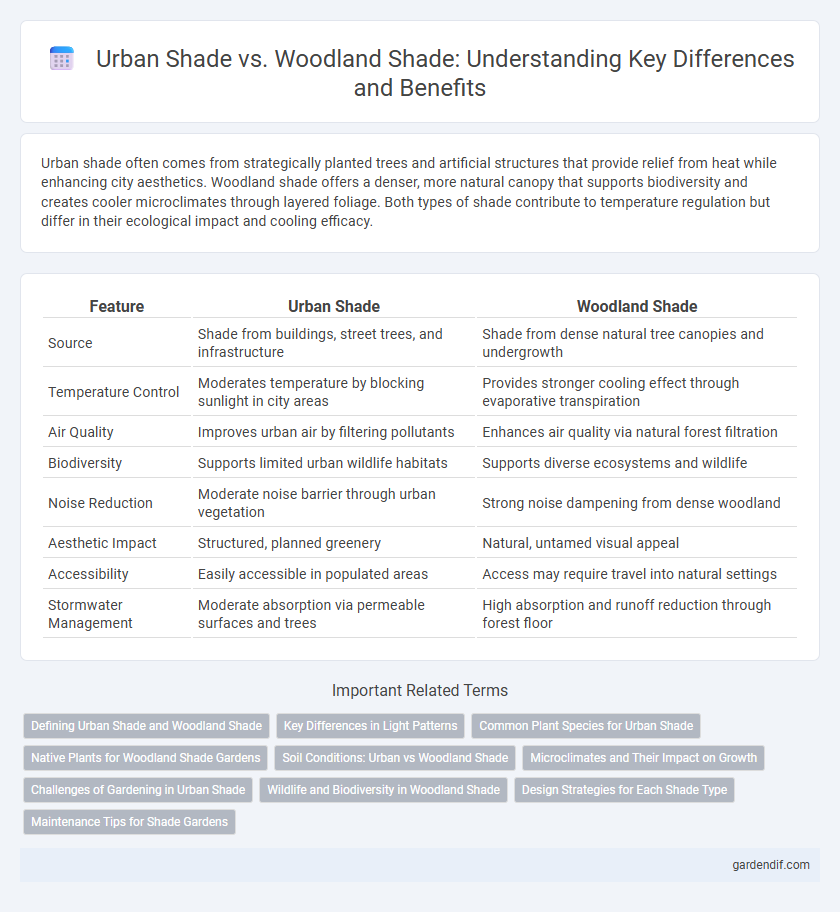
Urban Shade vs Woodland Shade Illustration
Urban shade often comes from strategically planted trees and artificial structures that provide relief from heat while enhancing city aesthetics. Woodland shade offers a denser, more natural canopy that supports biodiversity and creates cooler microclimates through layered foliage. Both types of shade contribute to temperature regulation but differ in their ecological impact and cooling efficacy.
Table of Comparison
| Feature | Urban Shade | Woodland Shade |
|---|---|---|
| Source | Shade from buildings, street trees, and infrastructure | Shade from dense natural tree canopies and undergrowth |
| Temperature Control | Moderates temperature by blocking sunlight in city areas | Provides stronger cooling effect through evaporative transpiration |
| Air Quality | Improves urban air by filtering pollutants | Enhances air quality via natural forest filtration |
| Biodiversity | Supports limited urban wildlife habitats | Supports diverse ecosystems and wildlife |
| Noise Reduction | Moderate noise barrier through urban vegetation | Strong noise dampening from dense woodland |
| Aesthetic Impact | Structured, planned greenery | Natural, untamed visual appeal |
| Accessibility | Easily accessible in populated areas | Access may require travel into natural settings |
| Stormwater Management | Moderate absorption via permeable surfaces and trees | High absorption and runoff reduction through forest floor |
Defining Urban Shade and Woodland Shade
Urban shade refers to shaded areas created by artificial structures like buildings, street trees, and constructed canopies within city environments, providing relief from heat and improving urban microclimates. Woodland shade is naturally formed by dense tree canopies in forested areas, offering extensive cover that regulates temperature, maintains soil moisture, and supports diverse ecosystems. Understanding the differences in origin and ecological functions between urban and woodland shade is essential for effective environmental planning and sustainable design.
Key Differences in Light Patterns
Urban shade typically features irregular light patterns due to buildings and artificial structures casting fragmented shadows, creating patchy and variable illumination. Woodland shade, in contrast, offers more diffuse and consistent light filtered through dense tree canopies, resulting in softer and more evenly distributed shade. These differences impact temperature regulation and plant growth, with urban shade often causing abrupt light changes, while woodland shade maintains a more stable microenvironment.
Common Plant Species for Urban Shade
Common plant species for urban shade include London plane tree (Platanus x acerifolia), red maple (Acer rubrum), and ginkgo (Ginkgo biloba), known for their resilience in city environments. These species tolerate pollution, compacted soil, and varying moisture levels better than typical woodland trees like oaks or beeches. Urban shade plants are selected for fast growth, canopy density, and minimal maintenance to improve air quality and reduce urban heat island effects.
Native Plants for Woodland Shade Gardens
Woodland shade gardens thrive with native plants such as Trillium, Jack-in-the-pulpit, and Wild ginger, which are adapted to low-light urban environments and enrich biodiversity. Unlike urban shade, which often requires hardy, pollution-tolerant species like Hostas and Japanese Maples, woodland shade supports understory plants that contribute to soil health and habitat complexity. Selecting native shade-tolerant plants ensures ecological balance, supports pollinators, and enhances the resilience of urban forest ecosystems.
Soil Conditions: Urban vs Woodland Shade
Urban shade environments often feature compacted soils with reduced organic matter and limited water infiltration, leading to poorer root growth and nutrient availability. Woodland shade typically benefits from well-structured, loamy soils rich in organic material and microbial activity, promoting healthier vegetation and soil moisture retention. These contrasting soil conditions significantly influence plant vitality and shade quality in urban versus woodland settings.
Microclimates and Their Impact on Growth
Urban shade often creates microclimates characterized by elevated temperatures and altered humidity due to heat absorption by buildings and pavements, impacting plant growth by increasing stress and water demand. Woodland shade provides a more stable microclimate with cooler temperatures and higher humidity, promoting healthier growth by reducing heat stress and maintaining soil moisture. These differences in microclimates influence species selection and growth rates, with urban environments favoring drought-tolerant and heat-resistant plants, while woodland settings support shade-loving, moisture-dependent species.
Challenges of Gardening in Urban Shade
Gardening in urban shade presents challenges such as limited sunlight due to tall buildings and reflective surfaces, which restrict photosynthesis and plant growth. Soil quality is often poor, compacted, and lacking organic matter, hindering root development and nutrient absorption. Urban shade environments may also suffer from higher pollution levels and heat retention, stressing shade-tolerant plants more than those in woodland shade.
Wildlife and Biodiversity in Woodland Shade
Woodland shade provides a diverse habitat supporting a rich variety of wildlife and higher biodiversity compared to urban shade. Native tree species in woodland areas create complex ecosystems that sustain birds, insects, and small mammals, enhancing ecological balance and pollination networks. This natural shade also promotes soil health and plant diversity, making woodland environments critical for conserving regional flora and fauna.
Design Strategies for Each Shade Type
Urban shade design strategies prioritize mitigating heat islands through reflective materials, strategically placed shade structures, and drought-tolerant vegetation to enhance microclimate cooling. Woodland shade design emphasizes preserving native tree canopies, maximizing biodiversity by integrating layered plantings, and maintaining natural soil health for sustainable habitat support. Tailoring shading elements to the specific light quality and environmental impact of each setting optimizes energy efficiency and ecological balance.
Maintenance Tips for Shade Gardens
Urban shade gardens require regular monitoring for pollution-related soil compaction and frequent pruning to manage limited sunlight exposure caused by buildings. Woodland shade gardens benefit from natural leaf litter, necessitating periodic clearing of excessive debris to prevent fungal growth and promote healthy understory plants. Both environments demand tailored watering schedules to accommodate varying moisture levels and prevent root rot in shade-tolerant species.
Urban Shade vs Woodland Shade Infographic

 gardendif.com
gardendif.com